by Gary Knox | May 22, 2014
 Nursery IPM Workshop
Nursery IPM Workshop
North Florida
Research and Education Center
May Building Seminar Room and On
-site Outdoor Nursery Facilities
155 Research Road Quincy, Florida 32351
June10-11, 2014
Don’t miss this hands-on, 2-day workshop focused on integrated pest management (IPM) for nursery crops! Learn how to save resources, reduce pest damage and pesticide use, and create a safer working environment for employees, all while earning 13 pesticide CEUs plus FNGLA CEUs! Georgia pesticide CEUs applied for.
You will learn to identify major pests, plant diseases, and weeds using live samples, lectures, and images. Horticulturists, plant pathologists, entomologists, and weed scientists – – from major universities across the southeastern U.S. – – will teach you about some of the latest technologies to prevent pests and use your smart phone as a pest scouting device. Each participant will receive a free copy of IPM Pro, a mobile device app for IPM in ornamental crops, as well as many printed reference materials. In-depth and focused on IPM in ornamentals, this workshop is one of kind and well worth your time!
Registration is only $15 but you must pre-register to participate; no walk-ins allowed! To register and for more information, go to the registration website
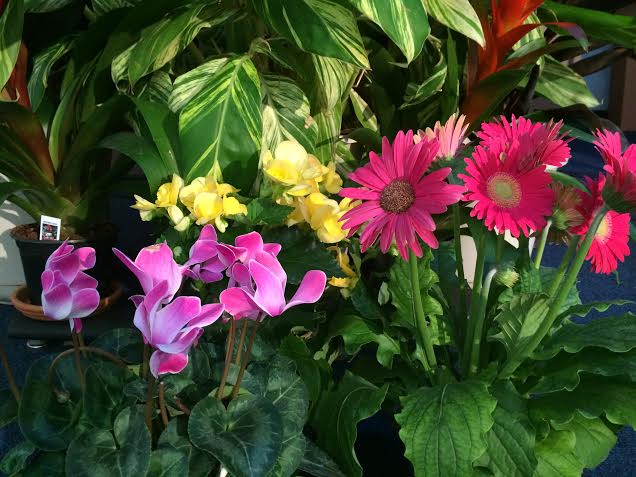
by Mary Salinas | May 13, 2014
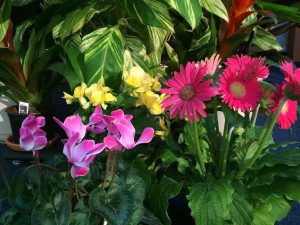
Flowering Houseplants. UF IFAS photo by Mary Derrick.
Plants add color, interesting textures and, of course, beauty to our indoor living environments. The air is freshened with the oxygen they provide.
Keep them healthy by watering correctly. Plants have differing water requirements so take a moment to look up some good research-based information on your particular plants and find out what kind of watering regime is best for them. For most houseplants, it’s time to water when the top inch or so of soil is dry to the touch. Some do best when they dry considerably before watering, like succulents, while others, like cineraria, like to stay evenly moist. It may help to group your plants by their water requirements so you can better remember and manage their watering needs.
When it is time to water, make sure to water thoroughly so that excess water drains from the pot. There are several really good reasons to follow that practice. First, a thorough watering allows all the soil and roots to be moistened and you avoid having dry spots in the soil. Also, when the excess water drains, it takes with it the excess salts from fertilizers. When excess salts build up over time, the roots can be damaged and the plant can eventually die. One of the first plant symptoms is brown, dead tips of the leaves. A definitive sign of excess salt is a white mineral build up around the inside edges of the pot or on the surface of the soil. If you already have a salt build-up, you can water heavily a few times to help leach the salts or re-pot your plant with some fresh potting soil.
One last tip – once you water your plants, don’t let the pots and the roots sit in water. Dump out any standing water.
For more information, please see:
Solutions for Your Life: Houseplants
Gardening Solutions: Salt Build-up in Houseplants
Virginia Extension: Indoor Plant Culture
by Julie McConnell | May 3, 2014
The last week of April 2014 brought with it 10-22 inches of rain across the panhandle in a matter of days. Some areas had immediate flooding and standing water, while others may be in areas at risk of rising rivers and streams. As the water recedes, many people are wondering how all the water will affect their landscapes.
Only time will tell what the long term impact will be, but here are a few things to watch for and what you can do to try to moderate damage.
- Let soils dry out before driving vehicles or other equipment on grassy areas. Even if the water is not visible, if the soil is still saturated, driving lawn equipment or cars may cause ruts.
- Do not leave automatic irrigation systems running on established shrubs, trees, and lawns. If your system is set to run in the early morning hours, you may not think about it being on, check your systems and hold off on adding water until soils dry out and the plants need it.
- Watch for fungus symptoms and treat if needed. Wet plants and cool weather are ideal for some Brown Patch on lawns, be aware and monitor landscapes closely. If disease is suspected, contact your local county extension office for recommendation.
- When mowing, leave a longer leaf blade to compensate for root stress.
- Look at the base of trees and shrubs to make sure silt and sand have not buried the crown or root flare. Also look for erosion of root zone, these areas may need correction. “Salvaging Flood-Damaged Shrubs and Ornamentals.”
- Adjust fertilization as needed; if you recently applied fertilizer it has likely runoff or leached from the site. However, if you suspect fungal disease do not fertilize until disease is managed.
- Stress in turfgrass, for details read “Watch Turf for Flooding Stress”
- You may see new weeds (seeds or segments may have washed or blown into your yard)
- Tree and shrub decline or death read “We Had Plenty of Rain, Why are My Trees Dying?”
- Although this storm was not a hurricane, “Assessing Damage and Restoring Trees After a Hurricane” has helpful information for areas with wind damage
- Nutritional deficiency symptoms in palms may show up 4-5 months from now. “Nutrient Deficiencies of Landscape and Field-grown Palms in Florida.”
- Decreased availability and increased price of sod (flooded fields prevent harvest and increase inputs for disease, weed, and nutrition management)
- Scheduling changes or maintenance adjustments by landscape contractors. Turfgrass and ornamentals will likely need different maintenance applications than in years past to correct issues related to flooding and excess rain.
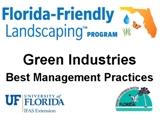
by Matthew Orwat | Mar 4, 2014
 In 2014, a new law took effect requiring all commercial fertilizer applicators (for hire) to have a license. This law was passed in 2009 and took effect on January 1 of this year. A requirement that must be completed to obtain this license is to successfully complete a Green Industries Best Management Practices (GI-BMP) training class. One option to fulfill this requirement is to enroll in a GI-BMP class at the local county extension office. This training is provided by UF IFAS extension at various extension offices across Florida in both English and Spanish.
In 2014, a new law took effect requiring all commercial fertilizer applicators (for hire) to have a license. This law was passed in 2009 and took effect on January 1 of this year. A requirement that must be completed to obtain this license is to successfully complete a Green Industries Best Management Practices (GI-BMP) training class. One option to fulfill this requirement is to enroll in a GI-BMP class at the local county extension office. This training is provided by UF IFAS extension at various extension offices across Florida in both English and Spanish.
These classes instruct green industry professionals in techniques of fertilizer, pesticide and irrigation application that help reduce and prevent pollution caused by runoff and leaching. Runoff and leaching is usually driven by rainfall and creates non-point source pollution. By learning how to implement the safest methods of fertilizer and pesticide application into their daily work, green industry professionals can do their part in the effort to maintain and improve Florida’s water quality and environment.
After receiving a certificate of completion, a person must pay $25 and apply to receive a limited certification for urban landscape commercial fertilizer application. A person possessing such a certification is not subject to additional local testing. The certification expires 4 years after the date of issuance and needs to be renewed at that time. Florida City and County employees that apply fertilizer as part of their job duties do not need to obtain the license to be in compliance with the new fertilizer rule, but they must complete the training and obtain a certificate of completion from the GI-BMP program.
[important]The Next GI-BMP class will be held Tuesday, March 11 at the UF IFAS Washington County Extension Office in Chipley Florida. This office is located at 1424 Jackson Ave (also US HWY 90) Suite A. It begins at 8am central time in the East Wing conference room. To register, contact Matthew Orwat or Cynthia Jackley at 850-638-6180 or mjorwat@ufl.edu Cost is $20.00 and lunch is provided.[/important]
The GI-BMP program has FDACS approval for 2 Core CEUs and 2 additional CEUs for the following licenses:
- Private Applicator – Agriculture
- Ornamental & Turf
- Limited Lawn & Ornamental
- Limited Landscape Maintenance
- Commercial Lawn and Ornamental
- Limited Commercial Fertilizer Applicators
- (2) Limited Urban Fertilizer credit hours
Article by Matthew Orwat and Sheila Dunning
by Sheila Dunning | Nov 11, 2013

It doesn’t take expert gardeners or landscapers to create a Florida-friendly yard. All it takes is a willingness to learn and a desire to build a beautiful yard that helps protect Florida’s environment. Florida-friendly landscaping is now part of state law. Florida Statute 373.185 prohibits government entities and homeowners associations from enacting or enforcing any governing document to prevent homeowners from implementing Florida-friendly landscaping (FFL) principles. A guideline to ease the development of a manual can be found at this link on the Florida Yards and Neighborhoods website. “Florida-Friendly Landscape Guidance Models for Ordinances, Covenants, and Restrictions.” 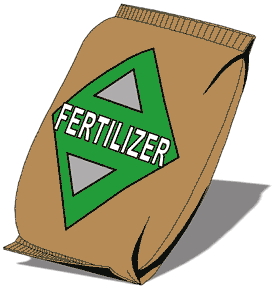 Florida Statutes 482.1562 states that all commercial fertilizer applicators must have a license from the Florida Department of Agriculture and Consumer Services (FDACS) by January 1, 2014. To get this license, each Green Industry employee must be trained in Best Management Practices, which teaches professionals how to implement FFL principles. Additionally, to address water conservation Florida Statute 373.62 says the following: “Any person who operates an automatic landscape irrigation system shall properly install, maintain, and operate technology that inhibits or interrupts operation of the system during periods of sufficient moisture, regardless of when the system was installed”. Irrigation contractors are required by law to ensure that there is an operational rain shut off device on site before they can perform any services. If it doesn’t exist or isn’t working, the contractor can be fined for not reporting the property owner or by completing the repair work without installing or repairing the rain shut off device.
Florida Statutes 482.1562 states that all commercial fertilizer applicators must have a license from the Florida Department of Agriculture and Consumer Services (FDACS) by January 1, 2014. To get this license, each Green Industry employee must be trained in Best Management Practices, which teaches professionals how to implement FFL principles. Additionally, to address water conservation Florida Statute 373.62 says the following: “Any person who operates an automatic landscape irrigation system shall properly install, maintain, and operate technology that inhibits or interrupts operation of the system during periods of sufficient moisture, regardless of when the system was installed”. Irrigation contractors are required by law to ensure that there is an operational rain shut off device on site before they can perform any services. If it doesn’t exist or isn’t working, the contractor can be fined for not reporting the property owner or by completing the repair work without installing or repairing the rain shut off device.
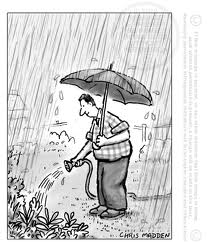 Fertilizing Appropriately and Watering Efficiently are just two of the nine Florida-friendly landscaping principles. Right Plant, Right Place; Mulch, Attracting Wildlife, Managing Yard Pests Responsibly, Recycling, Reducing Stormwater Runoff and Protecting the Waterfront.are the other principles. Utilizing landscape techniques that reduce the inputs that can negatively impact natural resources is the foundation of Florida-friendly landscaping. By implementing the practices, the user saves money, reduces their workload and protects the environment. Many of the Florida-friendly landscaping principles are common sense applications. For more information visit the Florida Yards website.
Fertilizing Appropriately and Watering Efficiently are just two of the nine Florida-friendly landscaping principles. Right Plant, Right Place; Mulch, Attracting Wildlife, Managing Yard Pests Responsibly, Recycling, Reducing Stormwater Runoff and Protecting the Waterfront.are the other principles. Utilizing landscape techniques that reduce the inputs that can negatively impact natural resources is the foundation of Florida-friendly landscaping. By implementing the practices, the user saves money, reduces their workload and protects the environment. Many of the Florida-friendly landscaping principles are common sense applications. For more information visit the Florida Yards website.
by Blake Thaxton | Sep 23, 2013
It has been a hot summer but Fall is right around the corner. Cooler temperatures and changing colors are a welcomed change in the panhandle of Florida. Fall can be a great time to spruce up your landscape with some new shrubs.
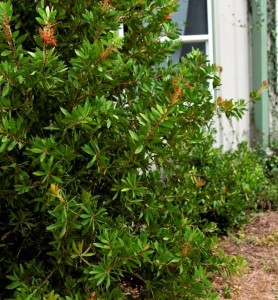
Image Credit UF / IFAS
It may be time for your landscape to receive a mini-makeover and to get a new look for fall and years to come. Perhaps some shrubs strategically placed will be what makes your outdoor living space pop. Proper selection and installation is key to health of the shrub moving forward.
Selection
There are several factors that need to be taken into account before buying shrubs to add to your landscape. Carefully selecting plants based on the following points will help with long term success of the plant:
- Climate – Be sure that the species will tolerate the climate you live in.
- Environment – Study the light level, acidity, and drainage of the planting site.
- Space – Account for the mature size of the plant before planting. This will keep you from having to remove the plant if the space is not adequate.
- Inspect the plant – Check for mechanical injury (scars and open wounds), cold injury, condition and shape of the canopy, and examine the root system.
Installation
Now that the proper plant has been selected it is time to give the shrub the best chance for survival with proper installation techniques. Fall and winter is an ideal time for planting shrubs. The roots can develop before the tops begin to grow in spring. The following are the keys to proper establishment of container shrubs.
- Root ball preparation – Remove the container from the root ball and inspect for circling roots. If there are circling roots than make three or four cuts vertically to cut the roots. Pull some of the roots away so they will take on a new growth direction (massage the roots). Also find the top most roots as sometimes they are covered by extra potting media. Remove the extra potting media so the top most roots are exposed and become the top of the root ball.
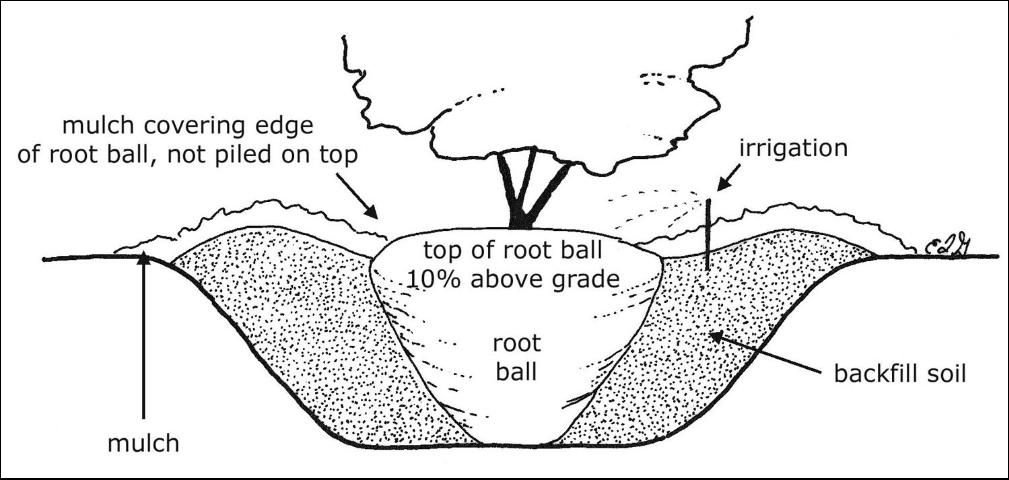
Image Credits: UF/IFAS, Edward F. Gilman
- Wider is better – Dig the hole two or three times the diameter of the root ball.
- Proper depth – Make sure to dig the hole 10% less than the height of the root ball. In poorly drained soils dig the hole 25% less than the the height of the root ball. The top most roots should be slightly above the native soils.
- Backfill – Fill the hole with existing soil half way and tamp the soil to settle. Again fill the rest of the hole with the existing soil and tamp again to settle the soil. Do not place any backfill soil or mulch over the root ball as it is crucial that water and air are able to be in contact with the the roots.
- Aftercare – Irrigate daily for the first two weeks, followed by every other day for the next two months, and weekly until the shrub is established (For <2 inch caliper shrubs).
If these key points are followed regarding selection and installation, the shrubs will be well on their way to becoming established in the landscape. If you would like read more in detail about installation please read the following:
Specifications for Planting Trees and Shrubs in the Southeastern U.S.
Literature:
Gilman, E.F., (2011, August) Specifications for Planting Trees and Shrubs in the Southeastern U.S.. Retrieved from: http://edis.ifas.ufl.edu/ep112
Black, R.J. and Ruppert, K.C., (1998) Your Florida Landscape, A complete guide to planting & maintenance. Gainesville, FL: University Press of Florida.
 Nursery IPM Workshop
Nursery IPM Workshop







